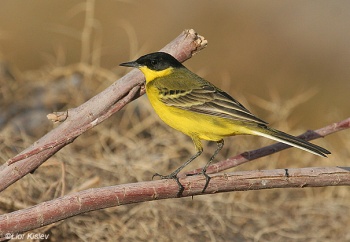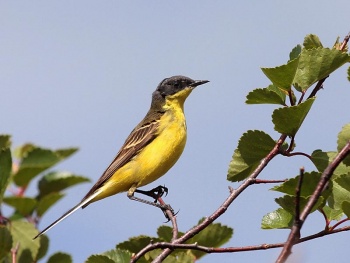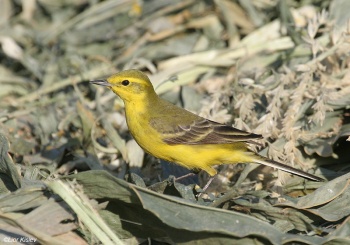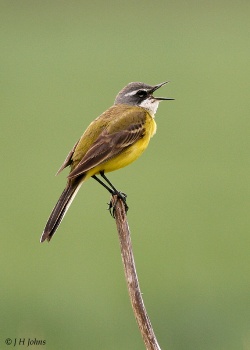Aloktewari (talk | contribs) (→Subspecies: ''beema'' : India added to the winter range.) |
(References updated. Picture placements) |
||
| Line 6: | Line 6: | ||
A wagtail with many plumage variations but all show uniform yellow breast and vent, most of the variation is to the head. A relatively short tail allows for differentiation of the grey headed varieties from the similar Grey Wagtail | A wagtail with many plumage variations but all show uniform yellow breast and vent, most of the variation is to the head. A relatively short tail allows for differentiation of the grey headed varieties from the similar Grey Wagtail | ||
====Variation and Similar Species==== | ====Variation and Similar Species==== | ||
| + | [[Image:Mff.jpg|thumb|350px|right|''feldegg'', Black-headed Wagtail<br />Photo by {{user|lior+kislev|lior kislev}}<br />Arava, [[Israel]], March 2008]] | ||
The races which have grey heads may look superficially like [[Grey Wagtail]]s but they usually have greener or browner backs. The shorter tails and different calls of the yellow wagtails are always conclusive. There are many races shown in the gallery. | The races which have grey heads may look superficially like [[Grey Wagtail]]s but they usually have greener or browner backs. The shorter tails and different calls of the yellow wagtails are always conclusive. There are many races shown in the gallery. | ||
| Line 12: | Line 13: | ||
[http://www.birdforum.net/showthread.php?t=58059 Thread] discussing identification of females. | [http://www.birdforum.net/showthread.php?t=58059 Thread] discussing identification of females. | ||
==Distribution== | ==Distribution== | ||
| + | [[Image:IMG 7804.jpg|thumb|350px|right|''thunbergi'', Grey-headed Wagtail<br />Photo by {{user|Macswede|Macswede}}<br />[[Fulufjallet National Park]], [[Sweden]], July 2008]] | ||
Common and widespread summer visitor to the region in a variety of races. Breeds in [[Britain]] (but absent from [[Ireland]] and most of [[Scotland]]), much of [[France]] and [[Iberia]] and east to the [[Urals]] and Caspian, reaching north to the White Sea in [[Russia]]. Occurs south to the north Mediterranean coast, [[Balearics]], [[Sardinia]], [[Crete]] and [[Cyprus]], throughout [[Turkey]] and at a few scattered sites in the [[Middle East]] such as Azraq in [[Jordan]] and the Hula Swamp in [[Israel]]. In North [[Africa]] found on the Banc D'Arguin of Mauritania, from [[Morocco]] to [[Tunisia]] and in the Nile Delta and Valley. Siberian races winter in [[India]], [[Indochina]], the [[Philippines]], [[Indonesia]] south to [[Australia]]. | Common and widespread summer visitor to the region in a variety of races. Breeds in [[Britain]] (but absent from [[Ireland]] and most of [[Scotland]]), much of [[France]] and [[Iberia]] and east to the [[Urals]] and Caspian, reaching north to the White Sea in [[Russia]]. Occurs south to the north Mediterranean coast, [[Balearics]], [[Sardinia]], [[Crete]] and [[Cyprus]], throughout [[Turkey]] and at a few scattered sites in the [[Middle East]] such as Azraq in [[Jordan]] and the Hula Swamp in [[Israel]]. In North [[Africa]] found on the Banc D'Arguin of Mauritania, from [[Morocco]] to [[Tunisia]] and in the Nile Delta and Valley. Siberian races winter in [[India]], [[Indochina]], the [[Philippines]], [[Indonesia]] south to [[Australia]]. | ||
| Line 17: | Line 19: | ||
Vagrants recorded north to [[Bear Island]], [[Iceland]] and [[Faroes]] and west to the [[Azores]] and [[Madeira]]. | Vagrants recorded north to [[Bear Island]], [[Iceland]] and [[Faroes]] and west to the [[Azores]] and [[Madeira]]. | ||
| − | |||
==Taxonomy== | ==Taxonomy== | ||
[[Eastern Yellow Wagtail]] from Siberia was formerly included in this species. | [[Eastern Yellow Wagtail]] from Siberia was formerly included in this species. | ||
====Subspecies==== | ====Subspecies==== | ||
| − | |||
[[Image:Lutea.jpg|thumb|350px|right|''lutea'', Khirgiz Steppe Wagtail<br />{{user|lior+kislev|lior kislev}}<br />Eylat, [[Israel]], May 2008]] | [[Image:Lutea.jpg|thumb|350px|right|''lutea'', Khirgiz Steppe Wagtail<br />{{user|lior+kislev|lior kislev}}<br />Eylat, [[Israel]], May 2008]] | ||
[[Image:Yellow-wag-2300.jpg|thumb|250px|right|''iberiae'', Spanish Wagtail<br />Photo by {{user|john-henry|john-henry}}<br />[[Extremadura]], [[Spain]], May 2005]] | [[Image:Yellow-wag-2300.jpg|thumb|250px|right|''iberiae'', Spanish Wagtail<br />Photo by {{user|john-henry|john-henry}}<br />[[Extremadura]], [[Spain]], May 2005]] | ||
| − | About 10-12 races occur in the Region differing mainly in head patterns of breeding male. Some races are considered full species by some authorities. | + | [[Image:IMG 23921.jpg|thumb|300px|right|Photo by {{user|RASHED|RASHED}}<br />[[Kuwait]], March 2010 ]] |
| + | About 10<sup>[[#References|[1]]]</sup>-12 races occur in the Region differing mainly in head patterns of breeding male. Some races are considered full species by some authorities. | ||
*''M.f. flava'', '''Blue-headed Wagtail''', breeds in mainland West and Central [[Europe]], migrates through North [[Africa]] and the [[Middle East]]. Scarce passage migrant in [[Britain]]. Blue-grey crown and nape and white supercilium, chin usually white. [[http://www.birdforum.net/gallery/data/527/58gelekwikstaart20040508mp002.jpg Link to Blue-headed Wagtail image]] | *''M.f. flava'', '''Blue-headed Wagtail''', breeds in mainland West and Central [[Europe]], migrates through North [[Africa]] and the [[Middle East]]. Scarce passage migrant in [[Britain]]. Blue-grey crown and nape and white supercilium, chin usually white. [[http://www.birdforum.net/gallery/data/527/58gelekwikstaart20040508mp002.jpg Link to Blue-headed Wagtail image]] | ||
| Line 55: | Line 56: | ||
Lowland grassland and wet meadows. | Lowland grassland and wet meadows. | ||
==Behaviour== | ==Behaviour== | ||
| + | [[Image:yellow_wagtail_alok.JPG|thumb|350px|right|''beema''<br />Photo by {{user|aloktewari|Alok Tewari}}<br />[[Okhla Bird Sanctuary]], [[India]], Jan-2013]] | ||
*On migration often seen in small mixed parties with [[White Wagtail|Pied and White Wagtails]] | *On migration often seen in small mixed parties with [[White Wagtail|Pied and White Wagtails]] | ||
*Often seen feeding near cattle. | *Often seen feeding near cattle. | ||
| Line 64: | Line 66: | ||
They are inclined to breed in small colonies, nesting in tussocks, laying 4-8 speckled eggs. | They are inclined to breed in small colonies, nesting in tussocks, laying 4-8 speckled eggs. | ||
====Vocalisation==== | ====Vocalisation==== | ||
| − | |||
<flashmp3>Motacilla flava (song).mp3</flashmp3><br /> | <flashmp3>Motacilla flava (song).mp3</flashmp3><br /> | ||
''[[Media:Motacilla flava (song).mp3|Listen in an external program]]'' | ''[[Media:Motacilla flava (song).mp3|Listen in an external program]]'' | ||
==References== | ==References== | ||
| − | #{{Ref- | + | #{{Ref-Clements6thAug17}}#Collins Pocket Guide to British Birds 1966 |
{{ref}} | {{ref}} | ||
==External Links== | ==External Links== | ||
| − | |||
{{GSearch|Motacilla+flava}} | {{GSearch|Motacilla+flava}} | ||
<br /> | <br /> | ||
Revision as of 01:22, 15 November 2017
- Motacilla flava
Identification
16·5 cm (6½ in)
A wagtail with many plumage variations but all show uniform yellow breast and vent, most of the variation is to the head. A relatively short tail allows for differentiation of the grey headed varieties from the similar Grey Wagtail
Variation and Similar Species
The races which have grey heads may look superficially like Grey Wagtails but they usually have greener or browner backs. The shorter tails and different calls of the yellow wagtails are always conclusive. There are many races shown in the gallery.
The main differences between the various races are described in the Taxonomy section.
Thread discussing identification of females.
Distribution
Common and widespread summer visitor to the region in a variety of races. Breeds in Britain (but absent from Ireland and most of Scotland), much of France and Iberia and east to the Urals and Caspian, reaching north to the White Sea in Russia. Occurs south to the north Mediterranean coast, Balearics, Sardinia, Crete and Cyprus, throughout Turkey and at a few scattered sites in the Middle East such as Azraq in Jordan and the Hula Swamp in Israel. In North Africa found on the Banc D'Arguin of Mauritania, from Morocco to Tunisia and in the Nile Delta and Valley. Siberian races winter in India, Indochina, the Philippines, Indonesia south to Australia.
North African populations and those from the Caucasus are resident or only partial migrants but most birds winter in sub-Saharan Africa. Small numbers may also occur in winter in southern Spain. Present on breeding grounds April-May until August-October, rarely later.
Vagrants recorded north to Bear Island, Iceland and Faroes and west to the Azores and Madeira.
Taxonomy
Eastern Yellow Wagtail from Siberia was formerly included in this species.
Subspecies
About 10[1]-12 races occur in the Region differing mainly in head patterns of breeding male. Some races are considered full species by some authorities.
- M.f. flava, Blue-headed Wagtail, breeds in mainland West and Central Europe, migrates through North Africa and the Middle East. Scarce passage migrant in Britain. Blue-grey crown and nape and white supercilium, chin usually white. [Link to Blue-headed Wagtail image]
- M.f. flava and M.f. flavissima form a narrow hybrid zone in northern France. Birds from this zone vary in appearance, but one type, which resembles nominate Blue-headed Wagtail (except that the blue tones to the head are paler and more mauve and the white of the head is more extensive, particularly on the throat, ear-coverts, and supercilium) is colloquially referred to as Channel Wagtail. [Link to Channel Wagtail image]
- M.f. beema, Sykes's Wagtail, breeds in Russia, migrates through Arabia the Middle East and India. Ash-grey crown and ear-coverts, broad white supercilium.
- M.f. leucocephala, White-headed Wagtail, breeds in Mongolia, rare visitor to the Middle East, head white, ear coverts very pale grey.
- M.f. cinereocapilla, Ashy-headed Wagtail, breeds Italy, Sardinia, Sicily and parts of east Adriatic coast, migrates through North Africa. Vagrant to Britain. Grey crown darker than flava, supercilium faint of absent.
- M.f. iberiae, Spanish Wagtail, breeds Iberian Peninsula and southern France, North-West Africa, migrates through North Africa. Grey crown darker than flava, narrow white supercilium, mainly or entirely behind eye. [[1]]
- M.f. pygmaea, Egyptian Wagtail, resident in Egypt. Small size, greenish-grey crown, blackish-green ear-coverts, white chin, dark blotches on breast-sides and little or no supercilium.
- M.f. thunbergi, Grey-headed Wagtail, breeds in northern Scandinavia and Russia, migrates through North Africa and Middle East. Dark grey crown, black ear-coverts, no supercilium, chin and throat yellow.
- M.f. feldegg, Black-headed Wagtail, breeds Balkans, Turkey and the Near East, migrates through Algeria, Libya and Egypt, Arabia and Middle East. Vagrant to Britain (<10 records). Crown and ear-coverts black, no supercilium, underparts entirely yellow. Sometimes considered to merit full species rank. [[2]]
- M.f. melanogrisea, breeds in south Russia and migrates south-east through Iran. Head black, olive back paler than feldegg, paler yellow below, chin white. [3]
- M.f. lutea, Khirgiz Steppe Wagtail, breeds in southern Russia from Lower Volga eastwards, migrates through Arabia and adjacent Middle East. Head yellow with olive ear-coverts, upperparts olive-green, entirely yellow below.
- M.f. flavissima, Yellow Wagtail, breeds Britain and coastal north-western Europe, migrates through North-West Africa. Crown and ear-coverts olive-green, forehead and supercilium yellow, underparts entirely yellow. The bird pictured is of the subspecies flavissima.
A couple of other forms are sometimes given names that look similar to subspecies but without formal recognition as such. These include "dombrowski" and "superciliaris".
Habitat
Lowland grassland and wet meadows.
Behaviour
- On migration often seen in small mixed parties with Pied and White Wagtails
- Often seen feeding near cattle.
Flight
Markedly dipping flight. Walks and runs, constantly dipping tail.
Diet
The diet includes small insects, flies and beetles.
Breeding
They are inclined to breed in small colonies, nesting in tussocks, laying 4-8 speckled eggs.
Vocalisation
<flashmp3>Motacilla flava (song).mp3</flashmp3>
Listen in an external program
References
- Clements, J. F., T. S. Schulenberg, M. J. Iliff, D. Roberson, T. A. Fredericks, B. L. Sullivan, and C. L. Wood. 2017. The eBird/Clements checklist of birds of the world: v2017, with updates to August 2017. Downloaded from http://www.birds.cornell.edu/clementschecklist/download/
- Collins Pocket Guide to British Birds 1966
Recommended Citation
- BirdForum Opus contributors. (2024) Western Yellow Wagtail. In: BirdForum, the forum for wild birds and birding. Retrieved 21 May 2024 from https://www.birdforum.net/opus/Western_Yellow_Wagtail
External Links











